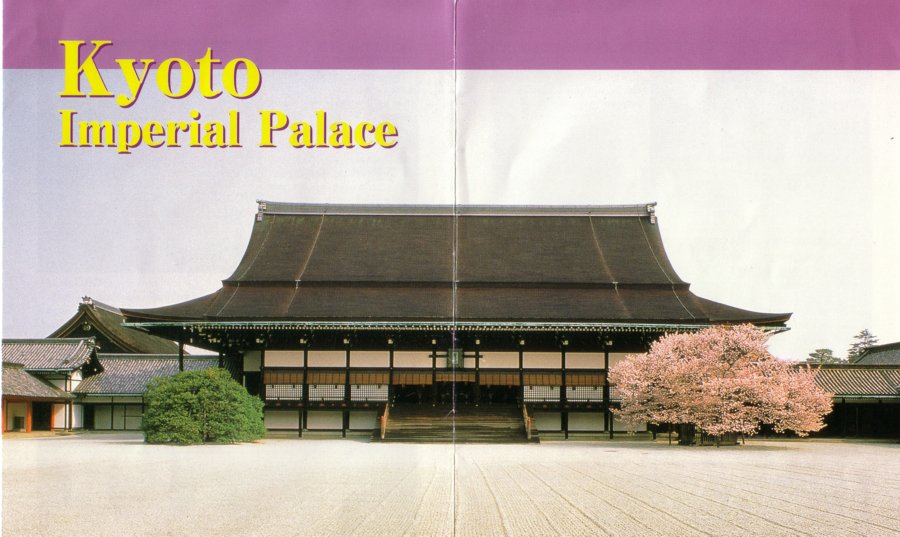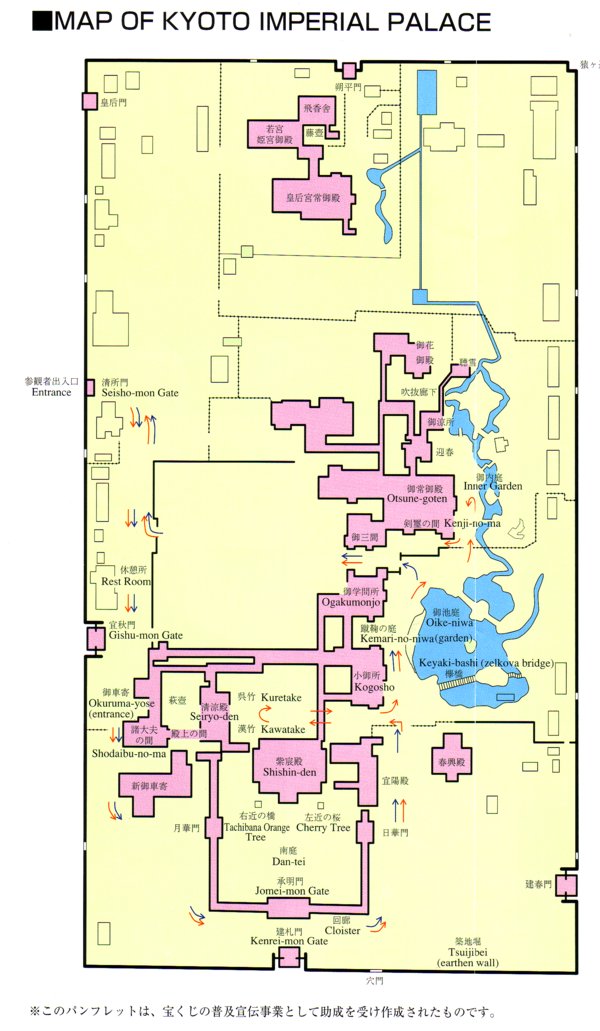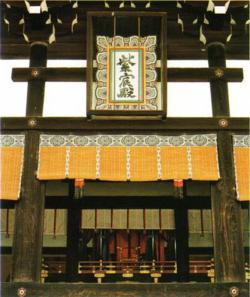|
|
|
 |
|
|
|
|
|
 |
|
|
|
|
|
|
 |
|
|
Der alte Kaiserpalast Kyoto
(Die einzelnen Gebäude)
|
|
|
|
|
|
|
History (Geschichte)
Kyoto was the capital of Japan for a period of over 1000 years. In 784, Emperor Kanmu moved the capital from Heijo-kyo in present-day Nara to Nagaoka-kyo in Kyoto. He moved the capital again in 794 to Heian-kyo, which was built in the center of present-day Kyoto City. The city measured approximately 5.3km from north to south and approximately 4.5km from east to west. It was constructed in a gridlike pattern, resembling a go board. The Emperors who succeeded Emperor Kanmu held court at the Imperial Palace in Heian-kyo, which served as both a political and cultural center. The Imperial Palace was situated in a fixed place, called the dairi, which was rebuilt every time it was destroyed by fire. While the Imperial Palace was being rebuilt, it was customary for the Emperor to move temporarily to the residences of members of the aristocracy. Later on, this custom came to be called satodairi. In the late Heian period, the dairi was not frequently used and the sato-dairi came to be used as the de facto Imperial Palace. During this period, the dairi was destroyed time after time by fire and warfare. It eventually fell into utter ruin, never to be rebuilt again.
The present Kyoto Imperial Palace is one of the sato-dairi palaces and came to be used often around the time when the Heian-period dairi was destroyed. From 1331, when Emperor Kogon was enthroned, and until the capital was moved to Tokyo in 1869, this sato-dairi served as the Imperial Palace. Over this period, the Imperial Palace was often destroyed by fire and then reconstructed. When it was rebuilt
after having burned down in 1788, the Shishinden and other major structures in the Palace compound were rebuilt in the traditional Heian style. In 1854, when the Palace burned down again, the Tokugawa Shogunate ordered that an Imperial Palace identical to its predecessor be immediately rebuilt, and the work was completed with exceptional speed by the following year. This is the Palace that still stands today.
Summary (Zusammenfassung)
The Kyoto Imperial Palace, which is surrounded by tsuijibei, or earthen walls with coping tiles, extends approximately 450m from north to south and 250m from east to west. It encompasses a total area of approximately 110,OOO qm (approximately 27 acres). In the south of the palace compound, Shishinden is an imposing structure that towers above all the others. It stands behind a courtyard that is laid with white sand. Seiryoden is situated to the northwest of Shishinden, Kogosho and Ogakumonjo to the northeast. These buildings face east. The magnificent Oike-niwa garden lies in front of Kogosho and Ogakumonjo. There are various other structures, which are differentiated as those used for ceremonial purposes and those used for everyday life. The Kyoto Imperial Palace represents an eclectic yet harmonized combination of traditional architectural styles, such as the shinden-, shoin- and sukiya-styles. It is also held in high regard as a piece of Japan's cultural heritage.
|
|
|
|
|
|
|
|
Okuruma-yose
This was the entrance used for official visits by courtiers who had been granted permission to enter the Palace precincts. |
|
|
Takamikura and Michodai
These structures are located in the center of the Shishinden. They are the Imperial thrones for the Emperor and Empress respectively and are used on the occasion of ceremony of enthronement. The Takamikura and Michodai were Constructed in the traditional style for the ceremony of enthronement of Emperor Taisho in 1915. These Imperial thrones were brought to Tokyo for the ceremony of enthronement of His Majesty Emperor Akihito. |
|
|
Ogakumonjo
Situated to the north of the Kogosho, this structure faces east with the kemari garden (see following explanation) inbetween. It was built in an architectural design similar to the shoin-style, with a floor and alcove shelves. It was used by the Emperor for study of such matters as politics, and was also used for poetry readings, where waka (a 31-syllable poem) would be read. |
|
|
Kogosho
This structure was used in ceremonies such as the Coming-of-Age Ceremony and on occasions when the Emperor received the shogun or daimyos. The Kogosho Conference, a crucial conference in which an order was given to restore Imperial Rule, thus changing the course of Japanese history, was held here on the night of 3 January 1868, a year before the Emperor moved his residence to Tokyo.
Kogosho was destroyed by fire in 1954 and rebuilt in 1958. |
|
|
 |
|
|
|
|
|
Shodaibu-no-ma
This building was used as a waiting area for courtiers paying official visits to the Palace. 'here are three rooms named after the objects painted on the fusuma (a sliding door): the Tiger Room, Crane Room and 'berry Room. Courtiers rested ,r waited in different rooms ccordino to rank. |
|
|
Seiryoden
For a long time before the separate Otsune-goten was built, this structure was used as the Emperor's residence. The structure is built in the traditional shinden-style like the Shishinden, but the floor is built much lower. The building has many more internal partitions, making it more appropriate as a residence for everyday life. This building is also renowned throughout Japanese literature.
Perhaps the best-known work in which Seiryoden is mentioned is The Tale of Genji. Written by Murasaki Shikibu in the 1 I'll century, this is a monumental work that describes court life in the Heian period in minute and vivid detail.
The east garden of Seiryoden is laid with white sand. Two types of bamboo, kuretake and kawatake, are grown there. |
|
|
Otsune-goten
Located to the north of the Ogakumonjo, the Otsune-goten is the largest structure in the Palace grounds. It has 15 rooms and is built in the shoin-style. There is a room called the Kenjino-ma in which the sword and seal, the symbols of the Imperial Throne, were preserved. The Emperor formerly used the Seiryoden as a place for daily life, but when Imperial Palace was restored at the end of the 16th century, the Otsune-goten was newly constructed reflecting the architectural style of the period. Thereafter the Emperors lived here until the capital was transferred to Tokyo in 1869. |
|
|
|
|
|
|
|
|
|
Shishinden
 |
The Shishinden, which was rebuilt in 1855, is the most important building on the Palace grounds, and was used for important ceremonies of state such as enthronement ceremonies. The Shishinden is the symbol of the Kyoto Imperial Palace and the enthronement ceremonies of Emperors Taisho and Showa were held here. The Shishinden is a one-story building purely made of wood. It was built in the architectural design of the irimoya (hipped and gabled roof) and Imperial Palace-style with high flooring. Its roof is made of hiwada, or layers of cypress bark. The building measures 37.7m in width and 20.5m in height. All around the building, there are shitomido (latticed shutters), which are suspended from iron hooks that are attached to the inside of the building. There are 18 steps leading up to the main entrance of the building. The slatted piece of flooring composed of six planks of wood, hanging in a frame over the main entrance, is an item that survived the 1854 fire. However, a replica of this relic is used today.
On the side of the stairs leading to the entrance, there is a cherry tree to the east and a tachibana orange tree to the west. To the front of the Shishinden there is an inner south garden laid with white sand. This garden, like the structure itself, serves an important role in ceremonies. |
|
|
|
Kemari-no-niwa
Kemari is a game that was played by palace courtiers and this is the space in which it was played.
The game was played with a ball made of deerskin and the objective was to pass the ball to one another while trying to keep the ball from falling to the ground. The kemari tradition has been passed down through the ages and is still played on occasion. |
|
|
|
Oike-niwa
The Oike-niwa is a strolling garden, the main feature of which is a large pond with an artificial shoreline toward the front and stepping stones across to a boat mooring place. There is an arc-shaped keyaki bridge that stretches across the pond. It is possible to enjoy this beautiful scenery from many different angles along the shore. |
|
|
|
 |
|
|
|
|
|
|
All Pictures / text: © Kikuyou Court Culture Institute
|
|
|
|
|
|
|
|
|
|
|
|
 Zurück zur Kyoto Seite / Back to the Kyoto site Zurück zur Kyoto Seite / Back to the Kyoto site
|
|
|
|
 |
|
|
|
Letzte Aktualisierung der Seite am :
Saturday, 18. June 2016
|
|
|
|
 |
|
|
 am alten Kaiserpalast in Kyoto
am alten Kaiserpalast in Kyoto  am alten Kaiserpalast in Kyoto
am alten Kaiserpalast in Kyoto